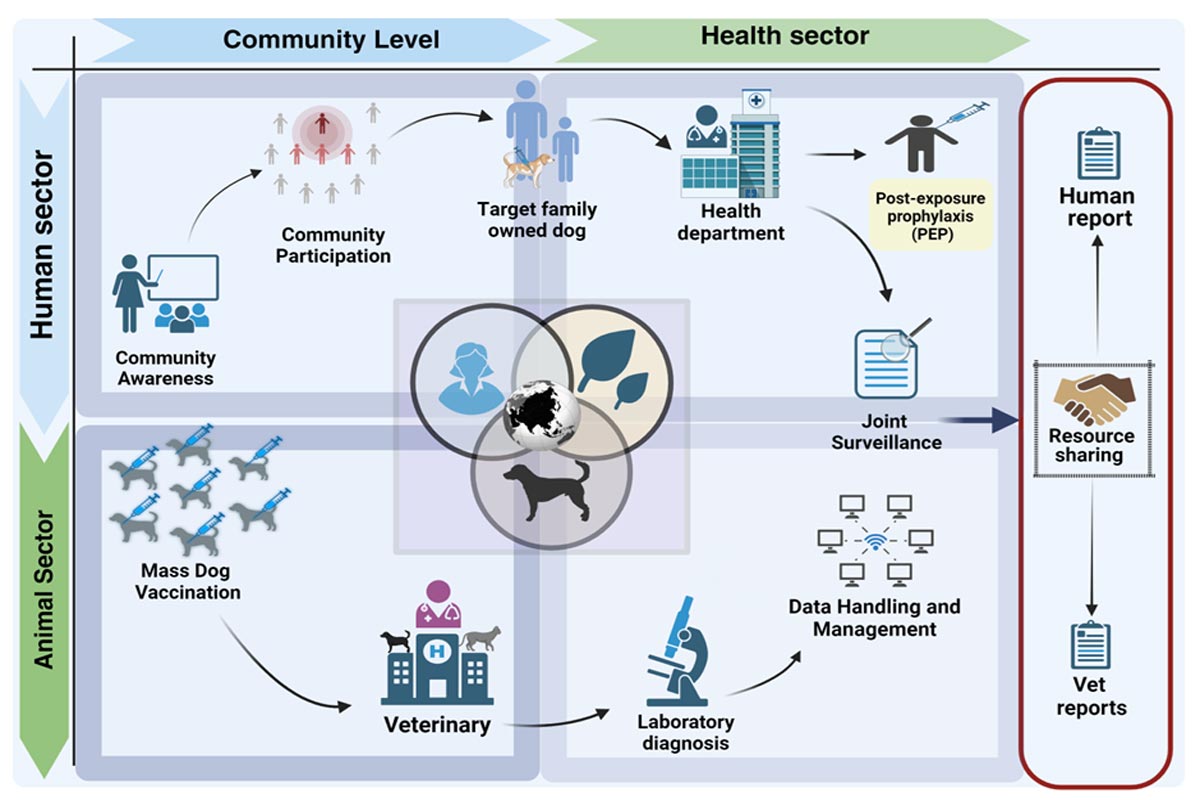Introduction
Rabies, a neglected zoonotic disease, continues to be a significant global health threat, causing considerable mortality worldwide, particularly in Asia [1]. Transmitted mainly through infected animal bites, rabies impacts all mammalian species, with the majority of human cases attributed to dog bites [2]. The virus is prevalent among other wildlife species, such as bats, cats, raccoons, skunks, and foxes, especially noted in regions like the Americas and Europe [3,4]. Although, nearly 90% of fatal human cases are traced back to bites from rabid dogs [5]. The highest incidence rates were observed in Asia, with 60% cases, followed by Africa at 36.4% [6]. Every year, more than 50,000 lives are claimed by rabies, highlighting the fatal nature of the disease [7]. Rabies poses not only a significant threat to health but also leads to considerable economic costs, with global estimates reaching around US$ 8.6 billion annually [8].
Asia faces a critical rabies problem, with the highest global death rates, where India contributes to 35% of these fatalities [2,9,10] closely followed by neighbouring Bangladesh [1]. Countries like Nepal, Myanmar, Bhutan, Thailand, and Indonesia experience moderate incidences of rabies, contributing to over half of the global cases linked to dog transmission [6]. Every nine minutes, rabies claims a life in Asia, with India experiencing the greatest loss of life and significant declines in quality of life, as measured by disability-adjusted life years (DALYs) [9]. Moreover, the financial burden of post-exposure prophylaxis (PEP) in Asia is the highest, with costs soaring to US$1.5 billion each year [1]. The disproportionate burden in Asia, particularly in India and Bangladesh, highlights the urgent need for enhanced rabies control measures, including widespread vaccination of dogs, public awareness campaigns, and improved access to affordable and effective PEP. Addressing these challenges is critical for reducing the incidence of rabies and alleviating its substantial health and economic impacts in Asia [11].
Addressing rabies in Asia necessitates a comprehensive One Health approach that synergizes public health education, animal management, and environmental stewardship. This entails not only raising awareness about rabies prevention and the significance of immediate care and post-exposure prophylaxis (PEP) but also ensuring PEP's accessibility and affordability, especially in underserved areas [5]. Key to this integrated strategy is the humane management of stray dog populations via Animal Birth Control (ABC) programs, directly tackling the primary rabies vector. Moreover, reinforcing legal frameworks and policies, such as mandatory dog registration and encouraging responsible pet ownership, plays a crucial role in a holistic rabies control ecosystem [10]. Community engagement is essential, with active involvement in vaccination drives and rabies reporting fostering a collective response to eradication efforts [12]. In addition to that, emerging technological innovations, such as the development of mobile apps for enhanced surveillance can offer promising avenues for improving detection and management of rabies [13]. Central to this One Health framework is the recognition that vaccinating dogs is not only the most efficient way to prevent rabies in humans but also a pivotal element of a broader, more cohesive strategy that bridges human health, animal welfare, and environmental considerations [14].
Expanding upon these initiatives, the integration of the One Health Approach into Asia's rabies control strategies can offer a pathway to not only address the current challenge but also to anticipate the future risks associated with rabies. The One Health Approach gained a lot of popularity in recent times due to its interdisciplinary nature in treating and controlling zoonotic and vector-borne diseases globally. The primary goals of this approach aims to boost human, animal, and environmental health, advance disease understanding and prediction, control diseases across species, and optimize resource use through multi-sector collaboration [15]. Through the implementation of the approach, Asian countries can improve surveillance, vaccination efforts, and public awareness of rabies prevention, crucially addressing the over 95% of cases stemming from dog bites with a multifaceted strategy [16].
Recognizing the multifaceted challenges rabies presents in Asia, from its widespread incidence and economic strain to the need for improved public health measures, the One Health approach emerges as a promising framework. The primary purpose of this scoping review is to evaluate and synthesize effectiveness of One Health interventions in managing rabies throughout various regions in Asia.


